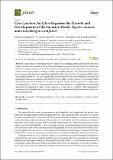| dc.contributor.author | Ngondya, Issakwisa | |
| dc.contributor.author | Treydte, Anna | |
| dc.contributor.author | Ndakidemi, Patrick | |
| dc.contributor.author | Munishi, Linus | |
| dc.date.accessioned | 2022-08-22T10:00:07Z | |
| dc.date.available | 2022-08-22T10:00:07Z | |
| dc.date.issued | 2019-12-06 | |
| dc.identifier.uri | https://doi.org/10.3390/plants8120576 | |
| dc.identifier.uri | https://dspace.nm-aist.ac.tz/handle/20.500.12479/1477 | |
| dc.description | This research article was published by MDPI, 2019 | en_US |
| dc.description.abstract | Approaches to managing invasive plants is challenging, particularly in protected areas where conventional methods, such as chemical herbicide applications are limited. We studied the effects of varying densities of Cynodon dactylon on the growth and development of the invasive weeds Tagetes minuta and Gutenbergia cordifolia in northern Tanzania. We conducted pot and field plot experiments following a completely randomized block design that was replicated three times. Increasing densities of C. dactylon significantly reduced growth, leaf total chlorophyll, biomass and significantly increased leaf anthocyanin of both T. minuta and G. cordifolia invasives. Our results further showed that the critical density of C. dactylon to suppress the two invasive species is ≥ 8 plants/m2. We suggest that C. dactylon can successfully be used as an alternative eco-friendly and sustainable approach for managing invasive weeds, such as T. minuta and G. cordifolia. This management technique can additionally improve forage production and biomass for wild and domestic herbivores in the affected areas. | en_US |
| dc.language.iso | en | en_US |
| dc.publisher | MDPI | en_US |
| dc.subject | Mexican marigold | en_US |
| dc.subject | Couch grass | en_US |
| dc.subject | Invasion | en_US |
| dc.subject | Rangeland | en_US |
| dc.subject | Common garden | en_US |
| dc.title | Can Cynodon dactylon Suppress the Growth and Development of the Invasive Weeds Tagetes minuta and Gutenbergia cordifolia? | en_US |
| dc.type | Article | en_US |

